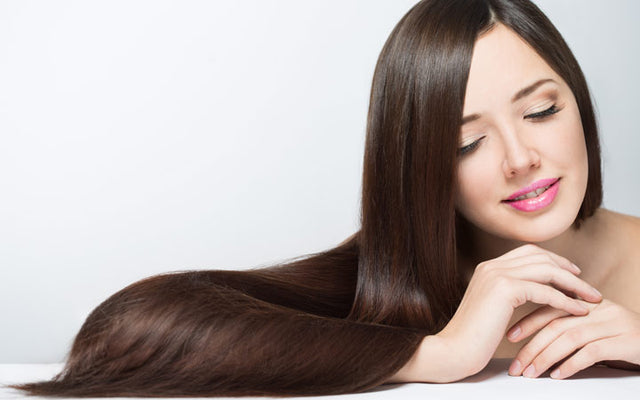Do you wish to flaunt sleek, silky and straight hair? Hair rebonding can give you desirable results permanently.
Most of us root for silky, straight mane, not just to ape the latest fashion, but also because it is easier to manage and style it. But, before setting off for a session, you must be aware of the procedure involved and everything else about it.
Scroll down to know more about hair rebonding treatment.
What Expert Says
“Any hair rebonding procedure will cause some hair loss. But avoiding harsh chemicals like formaldehyde can prevent hair damage to a certain extent.”
Dr. Harish Koutam, Chief Dermatologist, SkinKraft
Highlights:
- What Is Hair Rebonding?
- What Happens To Your Hair After Hair Rebonding?
- What Are The Tools/Ingredients Involved In Hair Rebonding?
- The Hair Rebonding Procedure
- Side-Effects Of Hair Rebonding
- Hair Care Tips Post Hair Rebonding
- How Long Do The Effects Of Hair Rebonding Last?
- Is Rebonding Suitable For Every Hair Type?
- Other Chemical Treatments To Get Straight Hair
- Difference Between Hair Rebonding And Hair Smoothening
What Is Hair Rebonding?
Hair rebonding is a chemical procedure that transforms the natural texture of your hair to help you achieve a sleek, silky, straight style. This technique involves the breaking of natural bonds in the hair chemically and then rearranging the bonds differently to give your hair a new look. Hair rebonding is ideal for those with frizzy and unmanageable hair.
What Happens To Your Hair After Hair Rebonding?
Your hair is made up of proteins. These are connected by disulphide bonds that give you your hair structure - straight, curly, wavy or coily. Hair rebonding is a technique that relaxes your hair bonds in order to restructure them. Towards the end of the process, your hair will start looking straight and frizz-free.
What Are The Tools/Ingredients Involved In Hair Rebonding?
- A mild shampoo
- A blow dryer
- Straightening brush
- A flat iron
- Steaming
- A relaxant
- A neutralizer
The Hair Rebonding Procedure
Step 1:
Your hair stylist will use a mild shampoo to clean your scalp and hair. This prepares it to go through the lengthy hair rebonding procedure. It might take 3-8 hours depending on the length and volume of your hair.
Step 2:
Your hair will be left to dry naturally. Your stylist may blow dry it as well.
Step 3:
Your hair will then be segregated into a number of sections to make sure that no strand of hair is missed out on.
Step 4:
Using plastic boards, every section of your hair will be coated with a relaxant, while making sure your hair is kept straight. The plastic boards are used to make sure that every strand of hair is completely covered in the product.
Step 5:
The cream is left on for about 30 minutes. If your hair is very dry, frizzy or curly, the product may be left on for more than 30 minutes.
Step 6:
Depending on the structure and texture of your hair, your stylist will steam it for 30-40 minutes.
Step 7:
Your stylist will now rinse and blow-dry your hair.
Step 8:
A keratin lotion will be applied to your hair, following which your hair will be sectioned again.
Step 9:
A neutralizer will now be applied to all the sections of your hair to stabilize the newly structured bonds. The product will be left on for another 30 minutes, after which it will be rinsed off.
Step 10:
After rinsing and blow-drying your hair, a serum will be applied. Your hair will now be straightened using a flat iron.
Post a hair rebonding treatment, your hair will appear smooth and silky straight. In case you've frizzy hair, you will notice less frizziness.
Side-Effects Of Hair Rebonding
Every chemical treatment has its own share of side-effects. Hair breakage, damage, dryness, etc. are some of the common side effects. Moreover, the application of harsh chemicals and heat at the time of the procedure may wreak havoc on your scalp, hair and its growth.
Dr. Harish Koutam, Chief Dermatologist at SkinKraft explains, “Any hair rebonding procedure will cause some hair loss. But avoiding harsh chemicals like formaldehyde can prevent hair damage to a certain extent.”
1. May damage your hair
Chemical treatments mean hair damage. Hair rebonding may cause your hair to break. The chemicals used in the process may also irritate your scalp. If you have sensitive skin, talk to your stylist before going ahead with the procedure.
2. Touch-ups are necessary
Note that your “rebonded” hair will always remain straight. You will have to keep touching-up the roots of your hair to get rid of your original structure and frizz. Touch-ups may also weaken your hair and result in hair loss in some cases.
3. High-maintenance
In order to prevent hair damage, you will have to invest in expensive products to protect it from breakage and dryness.
4. May not suit every hair type
Hair rebonding is not recommended for every hair type. You may have to talk to your hairstylist about which hair straightening method is recommended for you, depending on the texture of your hair.
Important Note:
Skip hair rebonding treatment during pregnancy. The procedure involves the usage of formaldehyde or aldehyde to break the hair bonds. There are chances that these chemicals pass from the scalp to your bloodstream and further harm the unborn child.
Hair Care Tips Post Hair Rebonding

1. Follow the 72-hour rule
Make sure you don’t wet your hair for 72 hours. It takes about 3 days for the bonds in your hair to stabilize. Avoid using pins and hair ties as well.
2. Follow your basic hair care regimen
Get yourself a shampoo specifically meant for straight hair. Condition your hair after every wash. Use a serum after you towel dry your hair. This will make your hair appear shiny and frizz-free. In addition to this, you may use homemade hair masks with curd, egg, etc. weekly once to deep condition it.
3. Oil your hair every now and then regularly
Oils help nourish your hair and maintain its health. Make sure you oil your hair regularly to keep it healthy and soft. However, for 3 days after the procedure, it is advised to stay away from anything that may not allow your hair bonds to stabilize.
4. Ensure you go to bed with straight hair
To avoid ruining the shape of your hair, make sure to keep your hair straight while you go to bed. Do this for 3 days before you wash your hair.
5. Stay away from heat
Avoid heat styling after a hair rebonding treatment to prevent any further damage. If you've to use a blow dryer, change its setting to cool.
6. Wear a shower cap
While taking a bath, wear a shower cap to protect your hair from water. Do this at least for a week after the treatment.
7. Eat Healthy
To keep your hair healthy, consume a balanced diet. This will ensure that the hair roots are strong and your hair growth is healthy.
8. Avoid Frequent Hair Washes
Your hair needs moisture. Hence, ensure that you don't overdo washing your hair. Keep it to 3-4 washes a week.
9. Trim Your Hair
Hair rebonding may damage your hair which means there will be split ends. Try to trim your hair every 6-8 weeks to prevent damage towards the tip of your hair.
How Long Do The Effects Of Hair Rebonding Last?
Hair rebonding usually lasts for 6-7 months. Touch-ups are necessary depending on the pace at which your hair grows. You may have to touch-up every 3 months or 6 months depending on how fast it takes for your hair to grow.
Is Rebonding Suitable For Every Hair Type?
Hair rebonding goes well with specific hair types. You should always consult your hairstylist about what chemical treatment is suitable for your hair type, to avoid any damage and breakage from taking place eventually.
Other Chemical Treatments To get Straight Hair
A number of other options are available in the market for you to choose from. These include:
- Keratin treatment (Brazillian treatment)
- Hair relaxing
- Japanese hair straightening
Talk to your stylist about which straightening method is recommended for your hair type.
Difference Between Hair Rebonding And Hair Smoothening
Hair rebonding technique aims to permanently restructure the bonds in your hair to give straight, silky hair. Hair smoothening, on the other hand, is designed to give you smooth, shiny hair. While rebonding is great for those with thick, curly, untenable hair, smoothening is apt for those with wavy, frizzy hair.
While there are subtle differences between both the processes, what treatment you opt for will completely depend on your hair type, needs, etc.
Wrapping Up
Your desire to achieve straight hair permanently can become a reality with hair rebonding. Hair rebonding employs chemicals and heat to help you to achieve straight hair. It has its share of side effects that include damaged hair and breakage. The treatment might not be suitable for all hair types. So consult your hairstylist before going for it. Make sure to take extra care of your hair post the treatment to derive maximum results.
Recommended Products
Was this Article helpful?
- Least helpful
- Most helpful





